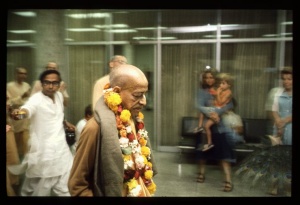SB 4.23.22

A.C. Bhaktivedanta Swami Prabhupada
TEXT 22
- vidhāya kṛtyaṁ hradinī-jalāplutā
- dattvodakaṁ bhartur udāra-karmaṇaḥ
- natvā divi-sthāṁs tridaśāṁs triḥ parītya
- viveśa vahniṁ dhyāyatī bhartṛ-pādau
SYNONYMS
vidhāya — executing; kṛtyam — the regulative function; hradinī — in the water of the river; jala-āplutā — taking bath completely; dattvā udakam — offering oblations of water; bhartuḥ — of her husband; udāra-karmaṇaḥ — who was so liberal; natvā — offering obeisances; divi-sthān — situated in the sky; tri-daśān — the thirty million demigods; triḥ — three times; parītya — circumambulating; viveśa — entered; vahnim — the fire; dhyāyatī — while thinking of; bhartṛ — of her husband; pādau — the two lotus feet.
TRANSLATION
After this, the Queen executed the necessary funerary functions and offered oblations of water. After bathing in the river, she offered obeisances to various demigods situated in the sky in the different planetary systems. She then circumambulated the fire and, while thinking of the lotus feet of her husband, entered its flames.
PURPORT
The entrance of a chaste wife into the flames of the pyre of her dead husband is known as saha-gamana, which means "dying with the husband." This system of saha-gamana had been practiced in Vedic civilization from time immemorial. Even after the British period in India this practice was rigidly observed, but soon it degraded to the point that even when the wife was not strong enough to enter the fire of her dead husband, the relatives would force her to enter. Thus this practice had to be stopped, but even today there are still some solitary cases where a wife will voluntarily enter the fire and die with her husband. Even after 1940 we personally knew of a chaste wife who died in this way.